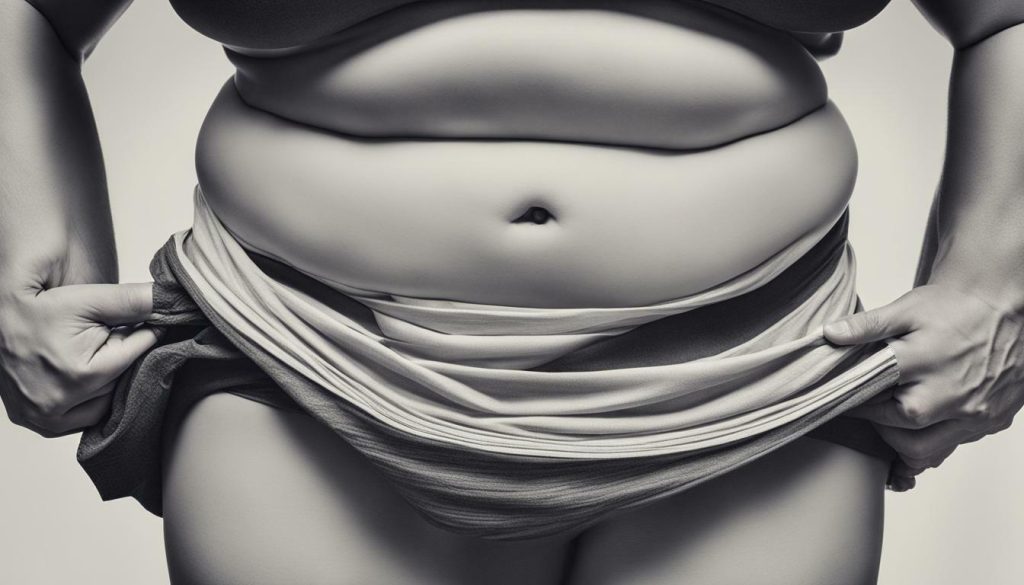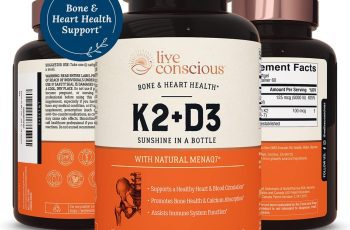
Apron belly, also known as a pannus stomach or mother’s apron, is excess tissue and fat that hangs down from the abdomen. It can occur after weight gain, weight loss, or pregnancy. Apron belly can increase the risk of certain cancers, heart disease, and type 2 diabetes, and it can cause emotional and physical discomfort.
To ease the discomfort caused by apron belly, there are several effective tips and techniques that can be followed. These include applying anti-chafing creams to minimize irritation, using support bands or clothing to provide extra support, and maintaining proper hygiene to keep the area clean and dry. These simple remedies can provide relief and improve overall comfort.
When it comes to reducing or getting rid of apron belly, focusing on overall weight loss through exercise and a healthy diet is crucial. Although spot reduction is not possible, incorporating abdominal exercises and full-body workouts can help tone and strengthen the abdominal muscles, leading to a reduction in the appearance of apron belly.
In some cases, surgical or nonsurgical options may be considered for apron belly treatment. Surgical procedures, such as laser treatments or a panniculectomy, can provide more immediate results. However, it is important to consult with a healthcare provider to discuss the risks and benefits of these procedures.
Nonsurgical treatments, such as making lifestyle changes, including exercise and adopting a healthy diet, can also contribute to reducing apron belly naturally. Seeking professional advice is essential to determine the most suitable treatment plan based on individual circumstances.
Here are some key takeaways:
- Apron belly is excess tissue and fat that hangs down from the abdomen and can cause emotional and physical discomfort.
- Applying anti-chafing creams, using support bands or clothing, and maintaining proper hygiene can help manage discomfort caused by apron belly.
- Focusing on overall weight loss through exercise and a healthy diet is important for reducing apron belly.
- Surgical options, such as laser treatments or a panniculectomy, should be discussed with a healthcare provider.
- Lifestyle changes, including exercise and a healthy diet, can contribute to natural apron belly reduction.
By following these tips and techniques, individuals can effectively address apron belly and work towards achieving a firmer and more confident midsection.
Understanding Apron Belly and its Risks
Apron belly can occur after weight gain, weight loss, or pregnancy and is characterized by excess tissue and fat that hangs down from the abdomen. This condition, also known as a pannus stomach or mother’s apron, can be a source of emotional and physical discomfort. It not only affects one’s self-confidence but also poses various health risks.

Apron belly can increase the risk of certain cancers, heart disease, and type 2 diabetes. The excess fat and tissue can contribute to hormonal imbalances and inflammation, which are linked to these health conditions. Furthermore, the added weight in the abdominal area puts strain on the organs and can lead to metabolic disorders.
To alleviate the discomfort caused by apron belly, there are several strategies that can be adopted. Using anti-chafing creams can help reduce friction and irritation in the area. Support bands or specialized clothing can provide additional support and help lift the apron belly, reducing strain on the back and hips. It is also essential to keep the area clean and dry to prevent any bacterial or fungal infections.
When it comes to reducing or removing apron belly, it’s important to emphasize overall weight loss through exercise and a healthy diet. Spot reduction, targeting only the abdominal area, is not possible. Engaging in regular physical activity, such as cardiovascular exercises and strength training, can help burn calories and promote overall weight loss. A diet that focuses on balanced nutrition, portion control, and nutrient-rich foods can complement exercise efforts and contribute to a healthier body composition.
| Risks | Health Conditions |
|---|---|
| Cancer risk | Increased risk of certain cancers |
| Heart disease risk | Elevated risk of heart disease |
| Type 2 diabetes risk | Higher likelihood of developing type 2 diabetes |
| Emotional discomfort | Impact on self-esteem and body image |
| Physical discomfort | Strain on back, hips, and other body parts |
For individuals seeking more immediate results, surgical or nonsurgical options may be considered. Laser procedures or a panniculectomy, which involves the removal of excess skin and fat, can be effective in reducing apron belly. However, it is crucial to consult with a healthcare provider to discuss the potential risks and benefits of these procedures, as they may not be suitable for everyone. Professional advice is essential in determining the most appropriate course of action based on individual circumstances.
Managing Discomfort: Tips and Techniques
To ease the discomfort caused by apron belly, there are several tips and techniques that can provide relief. One effective method is the application of anti-chafing creams, which help reduce friction and irritation in the abdominal area. These creams create a protective barrier, preventing skin-on-skin contact and alleviating the discomfort caused by chafing.
Another helpful strategy is the use of support bands or clothing. These provide gentle compression and support to the abdomen, reducing the strain on the surrounding muscles and tissues. Support bands can be worn discreetly under clothing, ensuring maximum comfort throughout the day. Additionally, choosing loose-fitting and breathable clothing can also aid in minimizing discomfort.
Maintaining proper hygiene in the area is essential for managing apron belly discomfort. Regularly cleaning the abdominal area and keeping it dry can help prevent skin infections and further irritation. Using mild soap and warm water during showering, followed by thorough drying, is recommended. It is crucial to pat the area gently with a soft towel to avoid rubbing or aggravating the skin. Remember to pay attention to skin folds and creases for thorough cleansing.
Incorporating these tips and techniques into your daily routine can help alleviate the discomfort caused by apron belly. However, if you are experiencing persistent or severe discomfort, it is essential to consult with a healthcare provider for further guidance and possible medical interventions.

| Tips and Techniques | Benefits |
|---|---|
| Application of anti-chafing creams | Reduces friction and irritation |
| Use of support bands or clothing | Provides compression and support to the abdomen |
| Maintaining proper hygiene | Prevents skin infections and irritation |
The Role of Exercise in Reducing Apron Belly
Regular exercise plays a crucial role in reducing apron belly and achieving a firmer midsection. While spot reducing an apron belly is not possible, incorporating targeted exercises into your fitness routine can help strengthen the abdominal muscles and contribute to overall weight loss. This comprehensive approach is essential for achieving long-term results.
To effectively reduce apron belly, it is important to engage in a combination of cardiovascular exercises and strength training. Cardiovascular exercises such as brisk walking, jogging, cycling, or swimming help burn calories and promote weight loss. Aim for at least 150 minutes of moderate-intensity aerobic activity each week to enhance calorie expenditure.
Strength training exercises that target the abdominal muscles can help tone and tighten the midsection, leading to a reduction in apron belly over time. Some effective exercises include planks, crunches, Russian twists, and leg raises. It is important to maintain proper form and gradually increase the intensity and duration of your workouts to avoid injury.
In addition to exercise, incorporating a healthy diet is crucial for overall weight loss and reducing apron belly. Focus on consuming nutrient-rich foods such as fruits, vegetables, lean proteins, whole grains, and healthy fats. Avoid or limit foods that are high in added sugars, saturated fats, and refined carbohydrates.
To track your progress and stay motivated, consider keeping a fitness journal or using a mobile app that allows you to record your workouts, monitor your diet, and set achievable goals. Remember to consult with a healthcare provider before starting any new exercise program, especially if you have any underlying medical conditions.

| Exercise | Repetition | Sets |
|---|---|---|
| Planks | Hold for 30 seconds | 3 sets |
| Crunches | 15 repetitions | 3 sets |
| Russian Twists | 20 repetitions | 3 sets |
| Leg Raises | 12 repetitions | 3 sets |
A Healthy Diet for Apron Belly Reduction
Alongside exercise, adopting a healthy diet is essential for reducing apron belly and achieving a flatter stomach. A well-balanced diet can help shed excess fat and promote overall weight loss, targeting problem areas, including the apron belly. Here are some key principles to keep in mind when it comes to a healthy diet for apron belly reduction:
- Eat nutrient-rich foods: Focus on incorporating a variety of fruits, vegetables, whole grains, lean proteins, and healthy fats into your meals. These foods provide essential nutrients while keeping you satisfied.
- Practice portion control: Be mindful of your portion sizes to avoid overeating. Use smaller plates and bowls to help control your portion sizes visually. Pay attention to your body’s hunger and fullness cues.
- Avoid processed foods and added sugars: Processed foods, such as sugary snacks and beverages, can contribute to weight gain and hinder your progress in reducing apron belly. Opt for whole, unprocessed foods whenever possible.
- Stay hydrated: Drinking an adequate amount of water is important for overall health and can help control cravings. Aim to drink at least 8 glasses of water per day.
- Be consistent: Consistency is key when it comes to a healthy diet. Strive to make sustainable, long-term changes to your eating habits rather than resorting to crash diets or extreme restrictions.
Remember, adopting a healthy diet is not about depriving yourself but rather making informed choices and nourishing your body. Consult with a healthcare provider or a registered dietitian for personalized guidance and to ensure that you are meeting your nutritional needs.

By combining regular exercise, like targeted abdominal workouts, with a healthy diet, you can effectively reduce apron belly and achieve a flatter stomach. Stay committed to your goals, be patient with the process, and celebrate small victories along the way. With dedication and consistency, you can make positive changes to your body and improve your overall well-being.
Surgical Options for Apron Belly
For individuals seeking a more immediate and drastic solution to their apron belly, surgical options may be considered. These procedures aim to remove excess tissue and fat from the abdominal area, resulting in a flatter and more contoured stomach. Two common surgical options for apron belly reduction are laser procedures and a panniculectomy.
| Laser Procedures | Panniculectomy |
|---|---|

|

|
| Laser procedures use advanced technology to target and remove excess fat and skin in the abdominal area. This minimally invasive technique typically involves the use of laser energy to disrupt fat cells, which are then removed through suction or other methods. Laser procedures can help tighten the skin and improve overall body contour. | A panniculectomy is a surgical procedure that involves the removal of both excess skin and fat from the lower abdomen. This procedure is often recommended for individuals who have a significant amount of excess tissue and require a more extensive intervention. A panniculectomy can help improve the appearance of the abdomen and alleviate physical discomfort. |
It is important to note that surgical options for apron belly should be considered carefully, and it is advisable to consult with a healthcare provider before pursuing any procedure. A healthcare provider can assess individual circumstances, discuss the risks and benefits of surgery, and provide personalized recommendations.
While surgical options may provide immediate results, it is essential to maintain a healthy lifestyle after the procedure to ensure long-term success. Regular exercise, a balanced diet, and self-care practices can help prevent the recurrence of apron belly and promote overall well-being.
Nonsurgical Treatments for Apron Belly
Nonsurgical treatments offer alternative options for individuals looking to reduce their apron belly through lifestyle changes. While surgical procedures like a panniculectomy or laser treatments may be effective for some, they can involve risks and recovery time. If you prefer to explore nonsurgical options first, there are several strategies you can incorporate into your daily routine to help address your apron belly.
Exercise: Regular physical activity is key to reducing excess fat and improving overall body composition. Engaging in aerobic exercises like brisk walking, cycling, or swimming can help burn calories and promote weight loss. Incorporating strength training exercises, such as planks, squats, and lunges, can also help strengthen and tone the abdominal muscles, leading to a firmer midsection.
Diet: A balanced and nutritious diet can support weight loss and contribute to a healthier body composition. Focus on consuming a variety of fruits, vegetables, whole grains, lean proteins, and healthy fats. Monitor portion sizes and practice mindful eating to avoid overeating. Avoid or limit processed foods, sugary beverages, and high-fat snacks, which can contribute to weight gain and abdominal fat accumulation.
Professional Advice: It is always recommended to seek professional advice when considering any treatment for apron belly. Consulting with a healthcare provider or a registered dietitian can provide personalized guidance and help develop a tailored plan to address your specific needs. They can assess your overall health, discuss potential underlying factors contributing to your apron belly, and recommend the most suitable combination of diet and exercise strategies for you.

Incorporating these lifestyle changes into your daily routine can serve as the foundation for reducing and managing apron belly. Remember that results may vary depending on individual factors, and it may take time to see significant changes. Patience, consistency, and a holistic approach are key to achieving long-term success in reducing and preventing apron belly.
| Nonsurgical Treatment Options | Benefits |
|---|---|
| Exercise | Reduces excess fat, improves body composition, strengthens abdominal muscles |
| Diet | Supports weight loss, promotes healthier body composition, reduces abdominal fat accumulation |
| Professional Advice | Personalized guidance, tailored plan, addresses specific needs |
Tips and Remedies for Apron Belly Reduction
In addition to exercise and diet, there are various tips and remedies that can be incorporated into one’s routine to reduce apron belly. These natural techniques and lifestyle changes can complement your overall efforts and help you achieve a firmer midsection. Here are some effective tips to consider:
- Hydration is key: Drink plenty of water throughout the day to keep your body hydrated. Proper hydration not only helps with digestion but also promotes a healthy metabolism, which can aid in reducing belly fat.
- Include fiber-rich foods: Foods high in fiber, such as fruits, vegetables, and whole grains, can help regulate your digestion and promote a feeling of fullness. This can prevent overeating and support healthy weight loss.
- Engage in regular physical activity: Incorporate regular cardiovascular exercises, such as brisk walking or cycling, into your routine. These activities can help burn calories and contribute to overall weight loss, including reducing apron belly.
- Practice stress management: Chronic stress can contribute to weight gain and hinder your progress in reducing apron belly. Explore stress-reduction techniques, such as meditation, yoga, or deep breathing exercises, to maintain a healthy mindset.
Remember, these tips and remedies should be used in conjunction with a balanced diet and regular exercise. It is also essential to consult with a healthcare provider before making significant changes to your routine, especially if you have any underlying health conditions or concerns.

By implementing these natural techniques and making lifestyle changes, you can take proactive steps toward reducing apron belly and achieving a healthier, more confident you.
| Tips and Remedies | Description |
|---|---|
| Hydration | Drink plenty of water to aid digestion and boost metabolism. |
| Fiber-rich foods | Incorporate fruits, vegetables, and whole grains for better digestion and satiety. |
| Regular physical activity | Engage in cardiovascular exercises to burn calories and promote weight loss. |
| Stress management | Practice techniques like meditation and yoga to reduce stress and support a healthy mindset. |
Seeking Professional Advice for Apron Belly Treatment
It is crucial to consult with a healthcare provider when considering apron belly treatment options to fully understand the risks and benefits. Apron belly, characterized by excess tissue and fat that hangs down from the abdomen, can have both physical and emotional implications. To address this concern effectively, it is essential to seek professional advice to determine the most suitable course of action.
Medical professionals possess expertise and knowledge that can guide individuals in making informed decisions regarding apron belly treatment. By discussing concerns, goals, and medical history with a healthcare provider, individuals can receive personalized recommendations tailored to their specific needs. They can explore various options, including surgical procedures such as laser treatments or panniculectomy.
During the consultation, healthcare providers can thoroughly explain the potential risks and benefits associated with each treatment choice. They can educate individuals on the expected outcomes, recovery process, and any potential complications. This information empowers patients to make well-informed decisions and ensures that their expectations align with realistic outcomes.
Engaging in open communication with a healthcare provider also allows individuals to address any doubts or questions they may have. Healthcare professionals can provide reassurance, address concerns, and offer guidance on post-treatment care to ensure optimal results. Remember, seeking professional advice is vital to embark on a safe and effective journey toward apron belly reduction.

| Treatment Option | Pros | Cons |
|---|---|---|
| Surgical Procedures | – Immediate results\n- Targeted fat removal\n- Potential for significant reduction | – General anesthesia\n- Surgical risks\n- Longer recovery time |
| Nonsurgical Options | – No anesthesia required\n- Minimal downtime\n- Lower cost compared to surgery | – Moderate to gradual results\n- May require multiple sessions\n- Limited effectiveness on larger apron bellies |
| Lifestyle Changes | – Sustainable approach\n- Overall health benefits\n- Budget-friendly | – Slow and gradual results\n- Requires dedication and commitment |
Maintaining a Healthy Lifestyle for Long-Term Results
Achieving long-term results in reducing apron belly requires adopting and maintaining a healthy lifestyle that includes regular exercise, a balanced diet, and self-care practices. By incorporating these habits into your daily routine, you can effectively manage your weight, improve overall health, and prevent the recurrence of apron belly.
Regular exercise plays a crucial role in reducing apron belly and keeping it off. Engaging in activities such as cardio workouts, strength training, and core exercises can help burn excess calories, strengthen abdominal muscles, and promote overall weight loss. Aim for at least 150 minutes of moderate-intensity exercise or 75 minutes of vigorous-intensity exercise every week.
A balanced diet is equally important in maintaining a healthy weight and reducing apron belly. Opt for nutrient-rich foods that are low in calories but high in vitamins, minerals, and antioxidants. Include plenty of fruits, vegetables, whole grains, lean proteins, and healthy fats in your meals. Practice portion control and avoid excessive consumption of sugary and processed foods.
Self-care practices are essential for overall well-being and can contribute to reducing apron belly. Prioritize stress management techniques such as meditation, yoga, or deep breathing exercises to minimize emotional eating and promote a healthy mindset. Get enough sleep and make time for relaxation to support your body’s natural healing processes.

Remember, consistency is key when it comes to maintaining a healthy lifestyle and achieving long-term results. Incorporate these habits gradually into your routine, listen to your body’s needs, and consult with a healthcare provider for personalized advice and guidance. With dedication and perseverance, you can successfully reduce and prevent apron belly while improving your overall health and well-being.
Conclusion
In conclusion, getting rid of apron belly naturally requires a holistic approach that includes exercise, a healthy diet, and lifestyle changes. Seeking professional advice for personalized treatment options is crucial.
Apron belly, also known as a pannus stomach or mother’s apron, refers to excess tissue and fat that hangs down from the abdomen. It can be a result of weight gain, weight loss, or pregnancy. However, it is important to address apron belly as it can increase the risk of certain cancers, heart disease, and type 2 diabetes, while also causing emotional and physical discomfort.
To manage the discomfort caused by apron belly, there are several techniques that can be employed. Applying anti-chafing creams, using support bands or clothing, and maintaining proper hygiene in the area can help alleviate discomfort and prevent skin irritation.
When it comes to reducing or removing apron belly, it is important to focus on overall weight loss through exercise and a healthy diet. Spot treating an apron belly is not possible, so it is essential to engage in activities that lead to overall weight loss. Additionally, incorporating a balanced diet with portion control and nutrient-rich foods can aid in achieving a firmer midsection.
If natural methods do not provide the desired results, there are surgical and nonsurgical options available. These may include laser procedures or a panniculectomy, but it is important to consult with a healthcare provider before considering any medical procedures. They can assess individual circumstances and discuss the potential risks and benefits of each option.
It is worth emphasizing that maintaining a healthy lifestyle is essential for long-term results in reducing and preventing apron belly. Regular exercise, a balanced diet, and self-care practices should be incorporated to ensure sustained success. Remember, seeking professional advice is key to developing a personalized treatment plan tailored to individual needs.
FAQ
What is apron belly?
Apron belly, also known as a pannus stomach or mother’s apron, is excess tissue and fat that hangs down from the abdomen. It can occur after weight gain, weight loss, or pregnancy.
What are the risks associated with apron belly?
Apron belly can increase the risk of certain cancers, heart disease, and type 2 diabetes. Additionally, it can cause emotional and physical discomfort.
How can I manage the discomfort caused by apron belly?
To ease discomfort, you can apply anti-chafing creams, use support bands or clothing, and keep the area clean and dry.
Can I spot reduce an apron belly?
Spot treating an apron belly is not possible. It is important to focus on overall weight loss through exercise and a healthy diet.
Is there a specific diet that can help reduce apron belly?
To reduce or remove an apron belly, it is important to focus on overall weight loss through a healthy diet. There is no specific diet that targets only the apron belly area.
What are the surgical options for apron belly?
Surgical options for apron belly may include laser procedures or a panniculectomy. These procedures should be discussed with a healthcare provider.
Are there nonsurgical treatments available for apron belly?
Nonsurgical options for apron belly include lifestyle changes such as exercise and diet. It is important to seek professional advice before pursuing any treatment.
Are there any tips or remedies for reducing apron belly?
Some tips and remedies for reducing apron belly include incorporating lifestyle changes and adopting healthy habits such as regular exercise and a balanced diet.
Is it necessary to consult a healthcare provider for apron belly treatment?
Yes, it is important to seek professional advice from a healthcare provider when considering apron belly treatment. They can assess individual circumstances and discuss potential medical procedures.
How can I maintain long-term results in reducing apron belly?
Maintaining a healthy lifestyle with regular exercise, a balanced diet, and self-care practices is crucial for achieving and sustaining long-term results in reducing apron belly.




